The natural shape of the hair shaft (curly, wavy, straight) is determined by the shape of the follicle. As the keratin hardens the shaft is compressed into it's shape by the follicle and held in that shape by the pattern of the chemical bonds inside it.
The tight curliness or coiliness of African hair stems in part from a flat follicle that causes the hair shaft to grow out in a curve. The shaft slants backward folding over into a spiral. The more and tighter the twists/spirals of the shaft, the curlier/coilier the hair will be. African hair is curly to the nth degree. This tight spiraling weakens the shaft, which is why African hair is most susceptible to damage.
Many black women grew up with relaxers in their hair. Every few weeks they religiously get their new growth touched up so that their hair will look "good." But at what price? Let's take a look at what chemical relaxers actually do to the hair shaft.
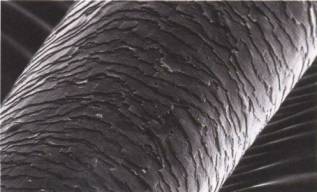
This is a picture of a healthy strand of hair with the normal minimal wear that comes from styling and handling the hair. Notice how the cuticles lie down smoothly.
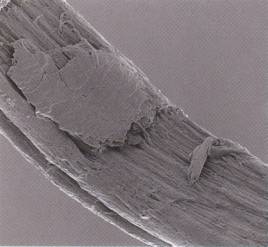
This is a picture of a hair strand that has been damaged by a relaxer. As you can tell a lot of the cuticles have broken off and exposed the cortex. Initial relaxing does not necessarily cause the dramatic change between the two pictures. However, chemical relaxers start the chain of events for damaged hair by weakening the hair shaft. Continual touch-ups combined with excessive heat styling continues the chain until the end result is what you see here. This is how it begins....
Relaxers are very strong chemicals that change the basic structure of the hair shaft. The curl pattern is loosened when the chemical penetrates the cortex. It reacts with the primary bonds responsible for structural stability and strength.
The two primary bonds are hydrogen and polypeptides.
Hydrogen gives hair its flexibility. It breaks down when the hair gets wet and reforms when the hair drys. Flexibility is important because the hair will break if it is resistant to manipulation. Relaxed hair has less flexibility because it is dryer so it breaks more easily than natural hair.
Polypeptides form protein chains that provide the hair's strength. These bonds are more difficult to break. That is why a relaxer requires strong chemicals. Once the polypeptides are destroyed they cannot be repaired. With the strength of the hair shaft removed there is nothing really holding the hair together. This encourages the next steps of hair damage: cuticles breaking down and breaking off layer by layer; exposed cortex; split ends; and hair breakage.
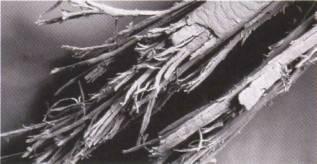 This is a picture of a hair strand that has been damaged by heat. Moisture is important to the health of the hair. Heat appliances reduce the moisture in the hair shaft below its normal level. They soften the keratin and can actually cause water inside the hair to boil. This weakens the hair and may cause it to break altogether. Heat damage is irreversable, but trimming the damaged part can prevent split ends.
This is a picture of a hair strand that has been damaged by heat. Moisture is important to the health of the hair. Heat appliances reduce the moisture in the hair shaft below its normal level. They soften the keratin and can actually cause water inside the hair to boil. This weakens the hair and may cause it to break altogether. Heat damage is irreversable, but trimming the damaged part can prevent split ends.

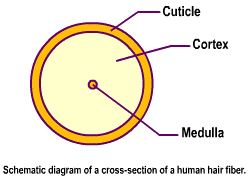
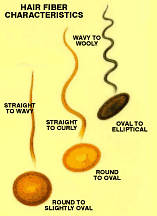



 This is a picture of a hair strand that has been damaged by heat. Moisture is important to the health of the hair. Heat appliances reduce the moisture in the hair shaft below its normal level. They soften the keratin and can actually cause water inside the hair to boil. This weakens the hair and may cause it to break altogether. Heat damage is irreversable, but trimming the damaged part can prevent split ends.
This is a picture of a hair strand that has been damaged by heat. Moisture is important to the health of the hair. Heat appliances reduce the moisture in the hair shaft below its normal level. They soften the keratin and can actually cause water inside the hair to boil. This weakens the hair and may cause it to break altogether. Heat damage is irreversable, but trimming the damaged part can prevent split ends.